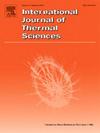大型室外卧式管状微藻光生物反应器厂通用温度模型
IF 4.9
2区 工程技术
Q1 ENGINEERING, MECHANICAL
International Journal of Thermal Sciences
Pub Date : 2025-04-12
DOI:10.1016/j.ijthermalsci.2025.109921
引用次数: 0
摘要
微藻光生物反应器(PBR)的设计、优化运行和产率评估都离不开菌液温度的影响,但目前尚无适用于大型室外围栏式水平管式PBR反应器的通用温度模型。温度模型是作为静态(位置、方向和反应堆几何形状)和动态(光辐照度、空气温度、风速和操作)参数的函数创建的。管间的相互遮蔽对肉汤温度有显著影响,这是经过仔细考虑的。该模型适用于单排和双排卷曲型pbr。随后利用该模型预测了10个双排盘曲pbr(每株2600 L无气体培养液)的培养液温度。通过对不同气候带藻类生产适宜性的分析,确定了亚热带和温带季风气候是藻类生产的有利地区。最后,比较了引起肉汤温度变化的各种传热率的相对大小。影响肉汤温度的主要因素是太阳辐射、空气对流和净长波辐射,而植物管状部分捕获的太阳直接辐射是最重要的因素。本文章由计算机程序翻译,如有差异,请以英文原文为准。

Universal temperature model for large-scale outdoor horizontal tubular microalgae photobioreactor plants
While the broth temperature is crucial for the design, optimal operation and yield assessment of the microalgae photobioreactors (PBRs), no universal temperature model is available for large-scale outdoor fence-type horizontal tubular PBR plants. A temperature model is created as a function of both the static (location, orientation, and reactor geometry) and dynamic (light irradiance, air temperature, wind velocity, and operation) parameters. The mutual shading among the tubes has a significant effect on the broth temperature and is carefully considered. The model is applicable to both single-row and double-row coiled types of PBRs. The broth temperature in a plant consisting of 10 double-row coiled PBRs, each with 2600 L of gas-free cultivation broth, was subsequently predicted using the model. Based on an analysis of the suitability of various climate zones for algae production, subtropical and temperate monsoon climates are identified as favorable regions. Finally, the relative magnitudes of the various heat transfer rates causing the change in broth temperature are compared. The primary factors affecting the broth temperature are solar radiation, air convection and net longwave radiation, and the direct solar radiation captured by the tubular part of the plant is the most substantial contributor.
求助全文
通过发布文献求助,成功后即可免费获取论文全文。
去求助
来源期刊

International Journal of Thermal Sciences
工程技术-工程:机械
CiteScore
8.10
自引率
11.10%
发文量
531
审稿时长
55 days
期刊介绍:
The International Journal of Thermal Sciences is a journal devoted to the publication of fundamental studies on the physics of transfer processes in general, with an emphasis on thermal aspects and also applied research on various processes, energy systems and the environment. Articles are published in English and French, and are subject to peer review.
The fundamental subjects considered within the scope of the journal are:
* Heat and relevant mass transfer at all scales (nano, micro and macro) and in all types of material (heterogeneous, composites, biological,...) and fluid flow
* Forced, natural or mixed convection in reactive or non-reactive media
* Single or multi–phase fluid flow with or without phase change
* Near–and far–field radiative heat transfer
* Combined modes of heat transfer in complex systems (for example, plasmas, biological, geological,...)
* Multiscale modelling
The applied research topics include:
* Heat exchangers, heat pipes, cooling processes
* Transport phenomena taking place in industrial processes (chemical, food and agricultural, metallurgical, space and aeronautical, automobile industries)
* Nano–and micro–technology for energy, space, biosystems and devices
* Heat transport analysis in advanced systems
* Impact of energy–related processes on environment, and emerging energy systems
The study of thermophysical properties of materials and fluids, thermal measurement techniques, inverse methods, and the developments of experimental methods are within the scope of the International Journal of Thermal Sciences which also covers the modelling, and numerical methods applied to thermal transfer.
 求助内容:
求助内容: 应助结果提醒方式:
应助结果提醒方式:


